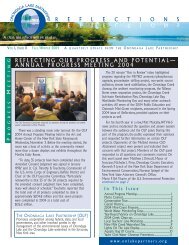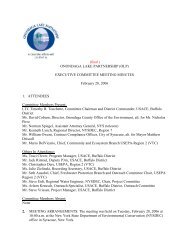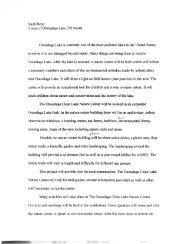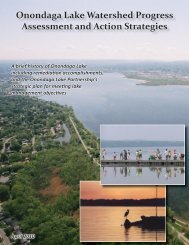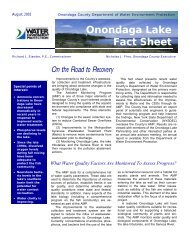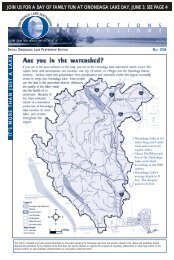Habitat Plan 2 - Onondaga Lake Partnership
Habitat Plan 2 - Onondaga Lake Partnership
Habitat Plan 2 - Onondaga Lake Partnership
Create successful ePaper yourself
Turn your PDF publications into a flip-book with our unique Google optimized e-Paper software.
DRAFTNYNHP also lists troublesome sedge (Carex molesta) along the SenecaRiver just north of the lake outlet.Sartwell’s sedge, a state-listed threatened species, was reported byGoodrich in the 1800s (Bye and Oettinger, 1969). There are no knownvoucher specimens for this plant from <strong>Onondaga</strong> County (NYFA, 2005),but it is considered a potential occurrence (Young, 2007). This sedge“is an important wetland species in portions of the Midwest, butbecomes increasingly uncommon and local eastward” (NYFA, 2005). Itshabitat in the eastern portion of its range includes marsh fens, rich fens,rich swamps, wet meadows and shallow water (Gleason 1952, NYFA2005, Fernald 1950, Wiegand and Eames 1926).Hairy small-leaved tick-trefoil or little-leaf tick-trefoil was collected in1991 in <strong>Onondaga</strong> County (NYFA, 2005). This species is consideredthreatened in New York State. Its habitat is “dry or sandy soil, sandywoods, clearings” (Gleason, 1952; Gleason and Cronquist, 1992;Fernald, 1950). There could be potential for this species to occur on thewastebeds that surround the lake.Red pigweed is a threatened species in New York State. It wasreported by Goodrich “among the salt vats” in the Town of Geddes inAugust 1897 (Goodrich, 1912) and was reported more recently in saltareas (Faust and Roberts, 1983). According to NYNHP records, avoucher specimen was collected by Fernald, Wiegand and Eames in1922. This plant of saline soil (also referred to as a “halophyte”) isfound in salt marshes, saline soil, and brackish soil (Gleason, 1950;Gleason and Cronquist, 1993; Fernald, 1950). Potential exists for thisspecies in areas of saline soils around the lake.Salt marsh aster was recorded in the Danforth’s Pool at the southernend of the <strong>Onondaga</strong> <strong>Lake</strong> Parkway (Young, 2007). Salt marsh aster isfound on Long Island and the New York City area. Its occurrence in<strong>Onondaga</strong> County is a disjunctive population. Its habitat is “coastal,primarily saline marshes with irregular inland distribution” (Gleason andCronquist, 1992).Two halophytes, seaside bulrush and eastern annual salt marsh asterwere recorded in the salt pools of <strong>Onondaga</strong> <strong>Lake</strong> by the NYNHPbotanist Steve Young (Young, 2007). Seaside bulrush is found in “freshsaline, or alkaline marshes.” This plant was found along <strong>Onondaga</strong><strong>Lake</strong> Parkway along the southeastern portion of the lake; it occurred ina roadside ditch in a former salt marsh area and in a salt pond(Danforth’s pool) in a mowed park. See Table 2.4 for more detailedinformation from the NY Natural Heritage Program.Southern naiad is represented by one common subspecies (spp.guadalupensis) and two state-listed rare subspecies (spp. muenscheriand spp. olivacea). Spp. olivacea is known from central New York inCayuga and Seneca Counties. Southern naiad was reported in fivesampling locations in the 2005 aquatic plant sampling for <strong>Onondaga</strong><strong>Lake</strong>. It was reported from just north of the Liverpool Yacht Club marinato the Maple Bay area; however, the specimens collected from<strong>Onondaga</strong> <strong>Lake</strong> were not identified to the subspecies level, so it is notknown whether it represents a rare subspecies.PARSONS | Remedial Design Elements for <strong>Habitat</strong> Restoration 71



